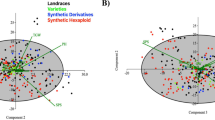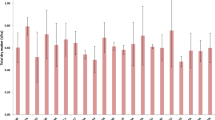Abstract
Drought is considered as most devastated environmental constraint which limits yield and productivity in rainfed rice ecosystem. Precise physiological introspection under water stress condition provides information regarding genetic variability, which helpful for effective breeding programmes. The current research initiates to screening out some popular short-grain aromatic rice germplasm from Koraput valley of Eastern Ghats to drought tolerance. Significant reduction of plant biomass, dry matter accumulation, leaf area, relative water content, CO2 photosynthetic rate, transpiration, stomatal conductance and water use efficiency were observed in studied rice seedlings under drought stress over to control plants. In addition, alteration of PSII photochemical activity was recorded under drought in studied genotypes. There was losing of sigmoidal shape of O-J-I-P transients noticed under drought stress. A pronounced increase of some antioxidant enzymes activities in some aromatic rice landraces under drought condition indicates its detoxification ability to oxidative stress. Based on PCA and cluster analysis some aromatic rice genotypes like Deulabhoga, Lactimachi, Sapuri showed 93% similarity with N22 and present in one cluster. These genotypes showed better growth, photosynthesis, and efficient antioxidant defence compared to IR64 (drought susceptible) during early growth stage. These identified genotypes might be evaluated in future for their genetic diversity and molecular mechanism towards drought tolerance for using in future crop breeding program.





Similar content being viewed by others
References
Abenavoli, M. R., Leone, M., Sunseri, F., Bacchi, M., & Sorgona, A. (2016). Root phenotyping for droughttolerance in bean landraces from Calabria (Italy). Journal of Agronomy and Crop Science, 202, 1–2.
Ahmadikhah, A., & Marufinia, A. (2016). Effect of reduced plant height on drought tolerance in rice. 3 Biotech, 6, 221.
Arnon, D. I. (1949). Copper enzymes in isolated chloroplasts Polyphenoloxidase in Beta Vulgaris. Plant Physiology, 24(1), 1–15.
Aro, E. M., Virgin, I., & Anderson, B. (1993). Photoinhibition of photosystem II, inactivation, protein damage and turnover. Biochimica Et Biophysica Acta, 1143(2), 113–134.
Arunachalam, V., Chaudhury, S. S., Sarangi, S. K., Ray, T., Mohanty, B. P., Nambi, V. A., & Mishra, S. (2006). Rising on rice: The story of Jeypore. pp. 1–37. MS Swaminathan Research Foundation, Chennai
Bhattacharjee, S., & Dey, N. (2018). Redox metabolic and molecular parameters for screening drought tolerant indigenous aromatic rice cultivars. Physiology and Molecular Biology of Plants, 24(1), 7–23.
Cakmak, I., & Marschner, H. (1992). Magnesium deficiency and highlight intensity enhance activities of superoxidedismutase, ascorbate peroxidase and glutathione reductase in bean leaves. Plant Physiology, 98(4), 1222–1227.
Calatayud, A., Roca, D., & Martınez, P. F. (2006). Spatial-temporal variations in rose leaves under water stress conditions studied by chlorophyll fluorescence imaging. Plant Physiology and Biochemistry, 44(10), 564–573.
Chowdhury, S. R., & Choudhuri, M. A. (1985). Hydrogen peroxide metabolism as an index of water stress tolerance in jute. Physiologia Plantarum, 65(4), 476–480.
Donde, R., Kumar, J., Gouda, G., Gupta, M. K., Mukherjee, M., Baksh, S. K. Y., Mahadani, P., Sahoo, K. K., & Behera, L. (2019). Assessment of genetic diversity of drought tolerant and susceptible rice genotypesusing microsatellite markers. Rice Science, 26(4), 239–247.
Ghosh, P., & Roychoudhury, A. (2018). Differential levels of metabolites and enzymes related to aroma formation in aromatic indica rice varieties: comparison with non-aromatic varieties. 3 Biotech, 8, 25.
Giannopolitis, C. N., & Ries, S. K. (1977). Superoxide dismutases: I Occurrence in Higher Plants. Plant Physiology, 59(2), 309–314.
Guei, R. G., Sanni, K. A., Abamu, F. J., & Fawole, I. (2005). Genetic diversity of rice (Oryza sativa L.). Agronomie Africaine, 5, 17–28.
Hayat, S., Hayat, Q., Alyemeni, M. N., Wani, A. S., Pichtel, J., & Ahmad, A. (2012). Role of proline under changing environments: A review. Plant Signaling and Behavior, 7(11), 1456–1466.
Hazrati, S., Tahmasebi-Sarvestani, Z., Modarres-Sanavy, S. A. M., Mokhtassi-Bidgoli, A., & Nicola, S. (2016). Effects of water stress and light intensity on chlorophyll fluorescence parameters and pigments of Aloe vera L. Plant. Physiology and Biochemistry, 106, 141–148.
Kalaji, H. M., Jajoo, A., Oukarroum, A., Brestic, M., Ziveak, M., Samborska, I. A., Cetner, M. D., Lukasik, I., Goltsev, V., & Ladle, R. J. (2016). Chlorophyll a fluorescence as a tool to monitor physiological status ofplants under abiotic stress conditions. Acta Physiologiae Plantarum, 38, 102.
Kautsky, H., & Hirsch, A. (1931). NeueVersuchezur Kohlensaureassimilation. Naturwissenschaften, 19, 964.
Khan, F., Upreti, P., Singh, R., Shukla, P. K., & Shirke, P. A. (2017). Physiological performance of two contrastingrice varieties under water stress. Physiology and Molecular Biology of Plants, 23(1), 85–97.
Kim, Y., Chung, Y. S., Lee, E., Tripathi, P., Heo, S., & Kim, K. H. (2020). Root response to drought stress in rice (Oryza sativa L.). International Journal of Molecular Sciences, 21, 1513.
Lauteri, M., Haworth, M., Serraj, R., Monteverdi, M. C., & Centritto, M. (2014). Photosynthetic diffusional constraints affect yield in drought stressed rice cultivars during flowering. PLoS ONE, 9(10), e109054.
Mathobo, R., Marais, D., & Steyn, J. M. (2017). The effect of drought stress on yield, leaf gaseous exchange and chlorophyll fluorescence of dry beans (Phaseolus vulgaris L.). Agricultural Water Management, 180, 118–125.
Maxwell, K., & Johnson, G. N. (2000). Chlorophyll fluorescence—a practical guide. Journal of Experimental Botany, 51(345), 659–668.
Mishra, S. S., Behera, P. K., Kumar, V., Lenka, S. K., & Panda, D. (2018). Physiological characterization and allelic diversity of selected drought tolerant traditional rice (Oryza sativa L.) landraces of Koraput, India. Physiology and Molecular Biology of Plants, 24(6), 1035–1046.
Mishra, S. S., Behera, P. K., & Panda, D. (2019). Genotypic variability for drought tolerance-related morphophysiological traits among indigenous rice landraces of Jeypore tract of Odisha, India. Journal of Crop Improvement, 33, 254–278.
Mishra, S. S., & Panda, D. (2017). Leaf traits and antioxidant defense for drought tolerance during early growth stage in some popular traditional rice landraces from Koraput, India. Rice Science, 24(4), 207–217.
Murchie, E. H., & Lawson, T. (2013). Chlorophyll fluorescence analysis: A guide to good practice and understanding some new applications. Journal of Experimental Botany, 64(13), 3983–3998.
Nahar, S., Vemireddy, L. R., Sahoo, L., & Tanti, B. (2018). Antioxidant protection mechanisms reveal significantresponse in drought-induced oxidative stress in some traditional rice of Assam, India. Rice Science, 25(4), 185–196.
Nakano, Y., & Asada, K. (1981). Hydrogen peroxide is scavenged by ascorbate specific peroxidase in spinach chloroplasts. Plant and Cell Physiology, 22(5), 867–880.
Panda, D., Mahakhud, A., Mohanty, B., Mishra, S. S., & Barik, J. (2018). Genotypic variation of photosynthetic gas exchange and stomatal traits in some traditional rice (Oryza sativa L.) landraces from Koraput, India for crop improvement. Physiology and Molecular Biology of Plants, 24(5), 973–983.
Panda, D., Mishra, S. S., Behera, P. K., & Lenka, S. K. (2021). Role of ascorbate and ascorbate–glutathione cyclefor photosynthetic protection in selected indigenous rice landraces under drought stress. Agricultural Research, 10(2), 187–192.
Panda, D., Mohanty, B., Behera, P. K., Barik, J., & Mishra, S. S. (2020). Harnessing leaf photosynthetic traits and antioxidant defence for multiple stress tolerance in three premium indigenous rice landraces of Jeypore tract of Odisha, India. Functional Plant Biology, 47, 99–111.
Panda, D., & Palita, S. K. (2021). Potential of underutilized wild crops in Koraput, Odisha, India for improving nutritional security and promoting climate resilience. Current Science, 120(6), 989–996.
Panda, D., Rao, D. N., Sharma, S. G., Strasser, R. J., & Sarkar, R. K. (2006). Submergence effects on rice genotypes during seedling stage: Probing of submergence driven changes of photosystem 2 by chlorophyll afluorescence induction O-J-I-P transients. Photosynthetica, 44(1), 69–75.
Pandey, V., & Shukla, A. (2015). Acclimation and tolerance strategies of rice under drought stress. Rice Science, 22(4), 147–161.
Patra, B. C., & Dhua, S. R. (2003). Agro-morphological diversity scenario in upland rice germplasm of Jeypore tract. Genetic Resources and Crop Evolution, 50(8), 825–828.
Prodhan, Z. H., & Qingyao, S. (2020). Rice aroma: A natural gift comes with price and the way forward. Rice Science, 27(2), 86–100.
Rao, M. V., Hale, B. A., & Ormrod, D. P. (1995). Amelioration of ozone induced oxidative damage in wheat plants grown under high carbon dioxide: Role of antioxidant enzymes. Plant Physiology, 109(2), 421–432.
Roy, P. S., Patnaik, A., Rao, G. J., Patnaik, S. S., Chaudhury, S. S., & Sharma, S. G. (2017). Participatory andmolecular marker assisted pure line selection for refinement of three premium rice landraces of Koraput, India. Agroecology and Sustainable Food Systems, 41(2), 167–185.
Sahoo, S., Saha, B., Awasthi, J. P., Omisun, T., Borgohain, P., Hussain, S., Panigrahi, J., & Panda, S. K. (2019). Physiological introspection into differential drought tolerance in rice cultivars of North East India. Acta Physiologiae Plantarum, 41, 53.
Samal, R., Roy, P. S., Sahoo, A., Kar, M. K., Patra, B. C., Marndi, B. C., & Gundimeda, J. N. (2018). Morphological and molecular dissection of wild rices from eastern India suggests distinct speciation between O. rufipogon and O. nivara populations. Scientific Reports, 8(1), 2773.
Sarkar, R. K., & Bhattacharjee, B. (2011). Rice genotypes with SUB1 QTL differ in submergence tolerance, elongation ability during submergence and re-generation growth at re-emergence. Rice, 5(1), 7.
Serraj, R., McNally, K. L., Slamet-Loedin, I., Kohli, A., Haefele, S. M., Atlin, G., & Kumar, A. (2011). Drought resistance improvement in rice: An integrated genetic and resource management strategy. Plant Production Science, 14(1), 1–14.
Singh, R., Pandey, N., Naskar, J., & Shirke, P. A. (2015). Physiological performance and differential expression profiling of genes associated with drought tolerance in contrasting varieties of two Gossypium species. Protoplasma, 252, 423–438.
Swapna, S., & Shyalaraj, K. S. (2017). Screening for osmotic stress responses in rice varieties (Oryza sativa L.) under drought condition. Rice Science, 24(5), 253–263.
Yang, X., Wang, B., Chen, L., Li, P., & Cao, C. (2019). The different influences of drought stress at the flowering stage on rice physiological traits, grain yield, and quality. Scientific Reports, 9, 3742.
Yoshida, S., Forno, D. A., Cook, J. H., & Gromes, K. A. (1976). Laboratory manual for physiological studies of rice. pp. 61–66. International Rice Research Institute, Philippines
Zhang, Q., Li, Q., Singh, V. P., Shi, P., Huang, Q., & Sun, P. (2018). Nonparametric integrated agrometeorologicaldrought monitoring: Model development and application. Journal of Geophysical Research, 123(1), 73–88.
Acknowledgements
Authors are grateful to Science and Technology Department, Govt. of Odisha project [Ref. No. 3340 (Sanc.)/ST/22.06.17], Director NRRI, Cuttack and Director, MSSRF, Jeypore are acknowledged for providing rice seeds for the experiments.
Funding
Science and Technology Department, Govt. of Odisha project [Ref. No. 3340 (Sanc.)/ST/22.06.17].
Author information
Authors and Affiliations
Contributions
SM, BSM and DP designed the experiments, PKB, SM and BSM performed the cultivation of plants and recording physiological and biochemical parameters. DP analyzed the data and wrote the paper. All the authors read and provided helpful discussions for the manuscript.
Corresponding author
Ethics declarations
Conflict of interest
The authors declare that they have no conflict of interest.
Additional information
Publisher's Note
Springer Nature remains neutral with regard to jurisdictional claims in published maps and institutional affiliations.
Rights and permissions
About this article
Cite this article
Panda, D., Behera, P.K., Mishra, S. et al. Differential drought tolerance responses in short-grain aromatic rice germplasms from Koraput valley of Eastern Ghats of India. Plant Physiol. Rep. 27, 119–131 (2022). https://doi.org/10.1007/s40502-021-00638-5
Received:
Accepted:
Published:
Issue Date:
DOI: https://doi.org/10.1007/s40502-021-00638-5




